Overview:
Power BI differentiates between null and blank values, where null signifies the absence of data and blank indicates an existing field without an assigned value, significantly impacting data analysis and reporting. The article emphasizes that understanding these distinctions is crucial for accurate data representation and decision-making, as poor handling of these values can lead to misinterpretations and inefficiencies in business intelligence processes.
Introduction
Navigating the complexities of data management in Power BI requires a keen understanding of null and blank values, which can significantly impact reporting and analysis. These seemingly simple concepts—where null signifies an absence of data and blank denotes a present but unfilled field—play a crucial role in ensuring the accuracy and reliability of insights derived from data.
As organizations strive to make informed decisions, the mismanagement of these values can lead to distorted outcomes and missed opportunities. By mastering the nuances of null and blank values, businesses can enhance their reporting capabilities, streamline operations, and leverage their data for strategic growth.
This article delves into practical implications, challenges, and best practices for effectively managing these values, empowering organizations to optimize their data analysis and drive operational efficiency.
Defining Null and Blank Values in Power BI
In Power BI, the concept of power bi null vs blank is important, as an empty value signifies the complete absence of data, while a void value indicates that a data field exists but lacks an assigned value. For instance, in the context of power bi null vs blank, if a customer record lacks an email address, that field is considered null. Conversely, if the email field is present but intentionally left empty, it is classified as blank according to the power bi null vs blank distinction.
Comprehending these definitions is essential, as they greatly affect aggregation, reporting, and visualization within your analysis. Effectively managing these principles not only enhances the functionality of your reports but also contributes to a more polished and professional presentation of data, which is essential in overcoming the challenges of time-consuming report creation and ensuring data consistency. This importance is underscored in the case study titled ‘Let’s Enhance Your Power BI Reports!’, which emphasizes that tackling blank entries can significantly enhance report aesthetics and functionality. Furthermore, as one user remarked regarding the limitations of managing these items, ‘That little checkbox in Hidden and Empty Cells that allows you to Show #N/A as an Empty Cell?’ That was what they gave me (and the rest of us) when they couldn’t create a NULL() function.
This viewpoint illustrates the genuine challenges encountered by users in managing these types of information. With 2,580 users currently online discussing these issues, it’s clear that this topic resonates within the community. By mastering the management of power bi null vs blank values, you empower yourself to make informed decisions in your practices, ultimately driving improved operational efficiency and leveraging the full potential of your Business Intelligence tools.
Moreover, failing to extract meaningful insights from your information can leave your business at a competitive disadvantage. Implementing RPA solutions can streamline the management process, enhancing efficiency and allowing you to focus on deriving actionable insights. Furthermore, establishing a strong governance strategy is essential to address inconsistencies, ensuring that your reports are reliable and trustworthy.
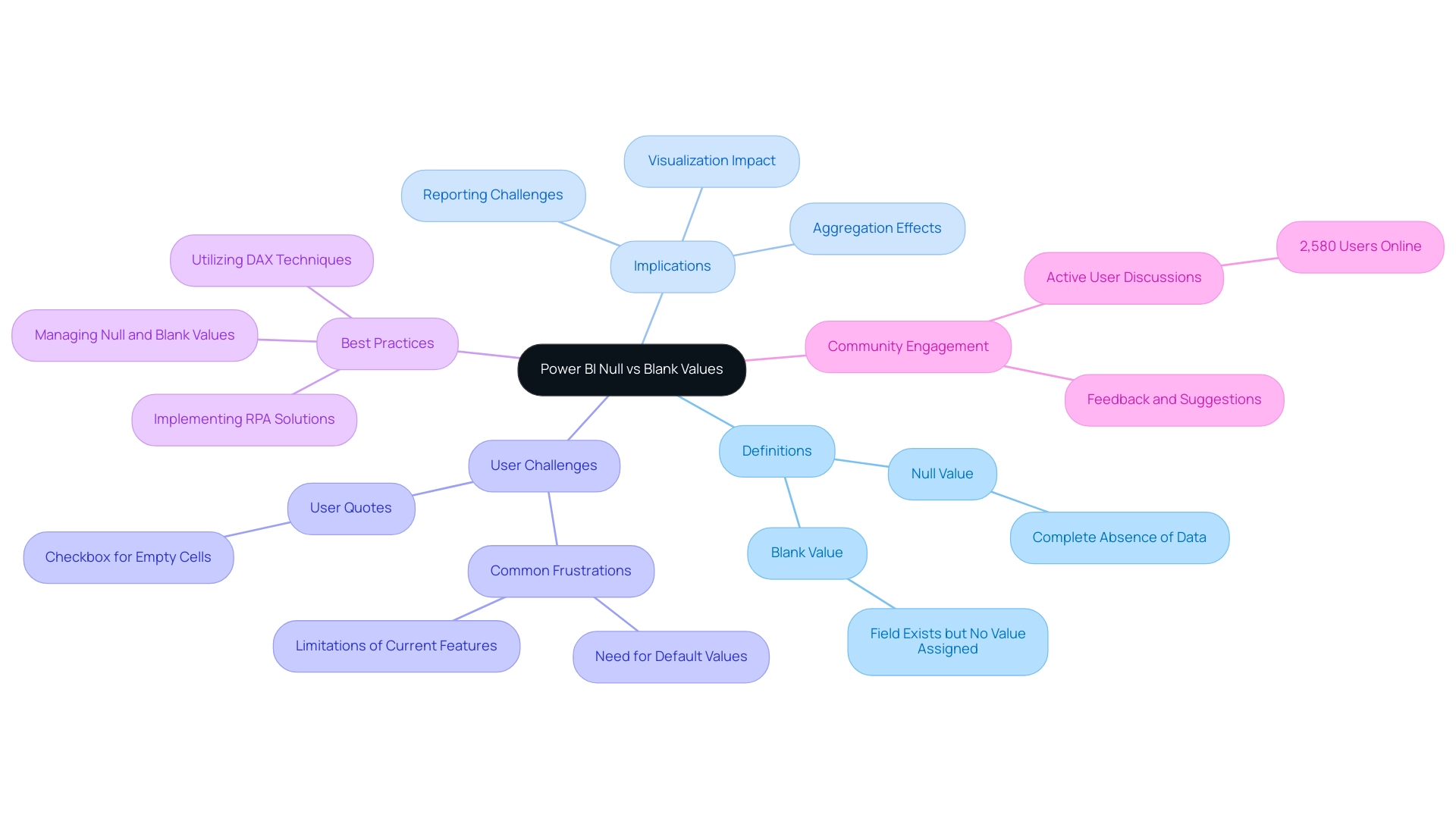
Practical Implications of Null vs Blank Values in Data Analysis
Poor handling of empty and missing data in analysis can greatly skew results and result in incorrect conclusions, substantially affecting your organization’s operational efficiency. For instance, if a sales report incorrectly treats null entries as zeros, the result is a significant misrepresentation of actual performance metrics. Furthermore, blank entries may be unintentionally overlooked in visualizations, resulting in lost opportunities for critical insights that could drive growth.
In today’s information-rich environment, ensuring integrity is paramount; it is vital to comprehend how these metrics interact with Business Intelligence tools to facilitate informed decision-making. Customized AI solutions can help organizations in effectively managing these values, ensuring precise information representation and analysis. Recent studies have highlighted discrepancies between protocols and their reported outcomes, emphasizing the need for robust management practices, especially when implementing AI solutions.
As Frank Harrell succinctly notes,
The consequence is an ego involvement with rejection of the hypothesis that often leads researchers to interpret hypothesis rejections as valid confirmations of their theoretical beliefs while interpreting nonrejections as uninformative and possibly the result of flawed methods.
This perspective is crucial when considering case studies like the one on estimating the distribution of the window period for recent HIV infections, where precise handling of information led to more accurate incidence estimations. To effectively handle values in Power BI null vs blank scenarios, understanding both explicit modeling approaches, which estimate parameters for distributions, and implicit modeling approaches, which compute algorithms for accurate imputation is essential.
For instance, utilizing BI tools can transform raw information into actionable insights by identifying patterns and trends that inform strategic decisions. Addressing these challenges not only enhances data quality but also strengthens the foundation for AI adoption within your organization, ultimately driving operational efficiency and informed decision-making.
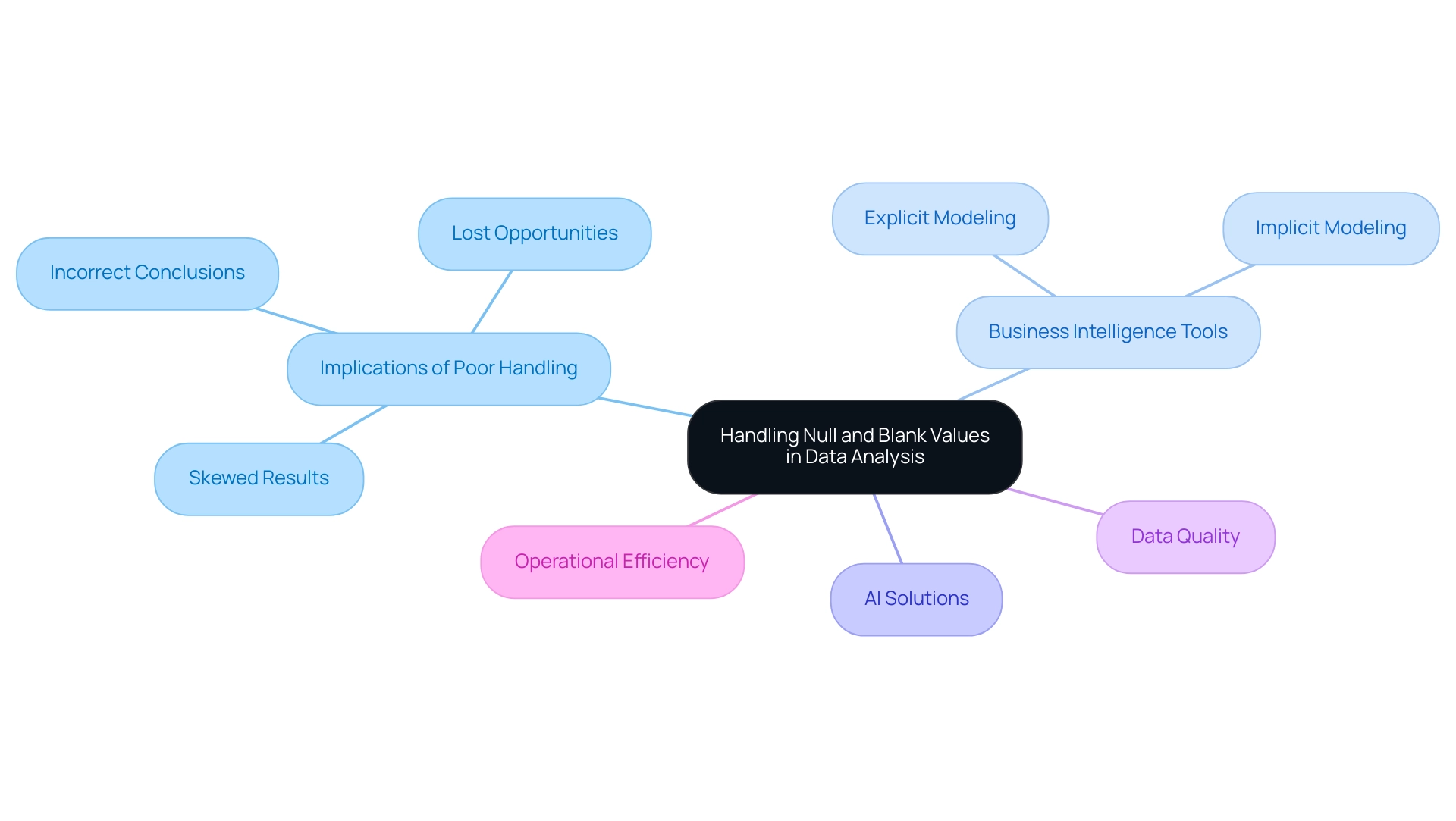
Understanding DAX Behavior with Null and Blank Values
In DAX, the ISBLANK() function is crucial for detecting empty entries, particularly in the context of power bi null vs blank, acknowledging that absent entries are frequently regarded as empties in different contexts. For instance, using the expression 'Product Category'[NumOfProducts] = COUNTROWS(RELATEDTABLE(Product)) effectively counts the number of products related to a category, showcasing how ISBLANK() can be applied to check if the count returns an empty result.
Furthermore, the COALESCE() function acts as a robust instrument for supplying alternative options when missing data or empty fields are encountered, avoiding possible calculation errors and improving the dependability of your reports.
This is particularly vital in a data-rich environment where accurate insights drive business growth and innovation. By efficiently managing empty and missing entries, organizations can greatly decrease the time invested in report generation, thus enhancing operational efficiency and staff morale. It’s important to note that a function has been deprecated, and users should refer to the Alternatives section for updated practices.
Furthermore, insights from the case study on equality comparisons with power bi null vs blank reveal that while blank is equal to 0 and an empty string when using the = operator, it is not when using the == operator. This highlights the importance of strict equality checks in DAX, especially when constructing accurate measures and calculated columns. By utilizing COALESCE() in situations where possible absences exist, you can ensure calculations proceed smoothly, leading to more reliable reporting outcomes that empower informed decision-making and operational efficiency.
Consider integrating RPA solutions alongside these DAX functions to further streamline your processes and enhance productivity. Book a free consultation to explore how we can assist you in leveraging these tools for your business growth.
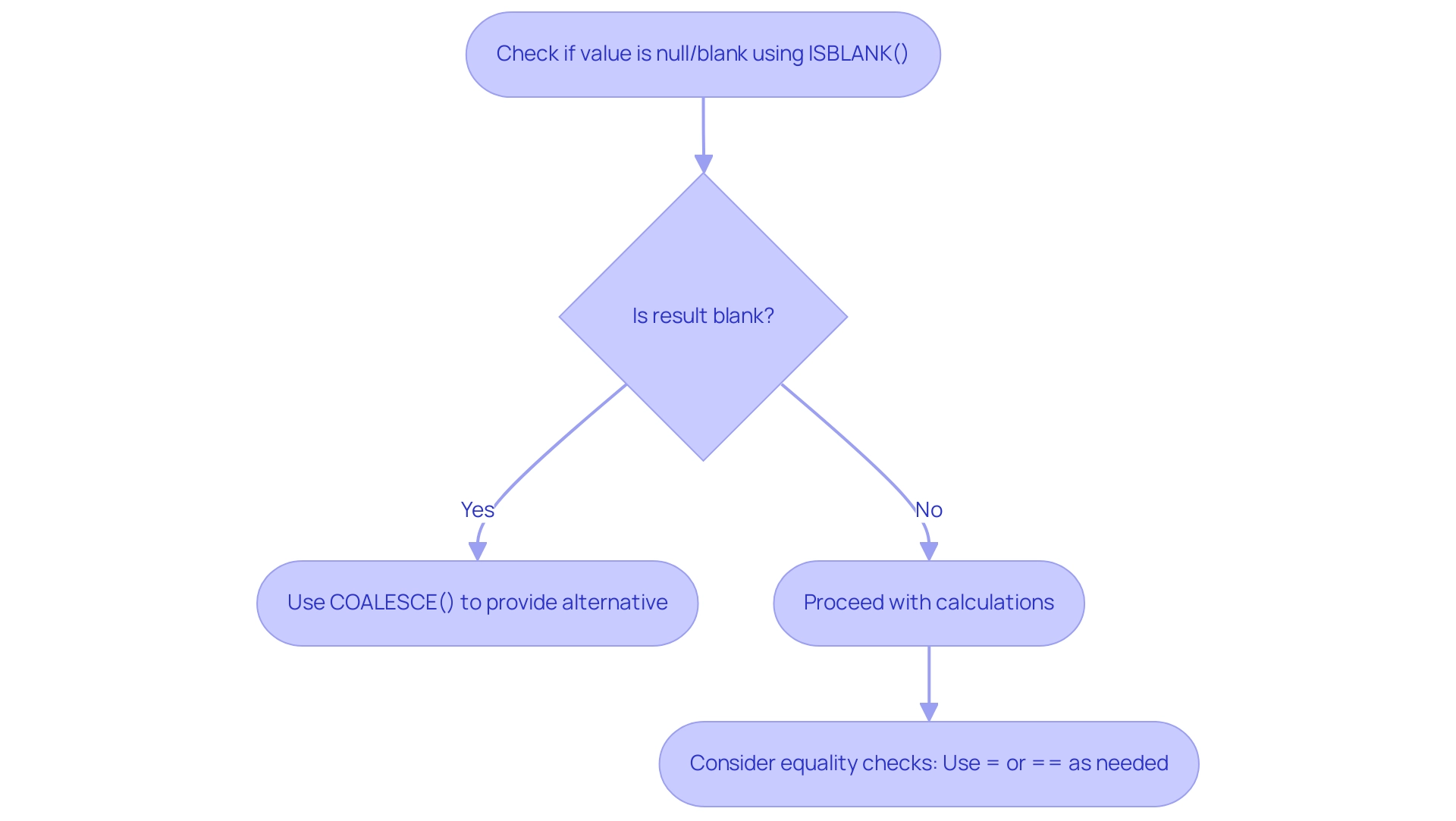
Challenges and Solutions for Managing Null and Blank Values
Handling empty and void entries during import in Power BI poses several typical obstacles that can greatly affect analysis. One prevalent issue in Power BI is the misinterpretation of blank fields versus null values, which can create confusion and inaccuracies in reporting. For instance, statistics from Quadratic Interpolation yield results such as 85.00000, 92.00000, and 78.00000, highlighting how absent information can skew analysis outcomes.
To effectively mitigate this risk, it is crucial to ensure that information sources are consistently checked for accuracy and completeness before importing them into Power BI. This is where our 3-Day Power BI Sprint can be transformative; in just three days, we promise to create a fully functional, professionally designed report that leverages the insights derived from your information. Utilizing DAX functions, such as IFERROR(), serves as a powerful strategy to handle unexpected conditions related to power bi null vs blank during calculations.
This function can help maintain the integrity of your analytics by allowing for alternative outcomes when errors arise. Furthermore, implementing regular information cleansing and validation processes is vital in ensuring reliable and accurate reporting. As Anand Shaw aptly put it, ‘Can you make a video on this topic?’ – emphasizing the ongoing need for education on these challenges.
Additionally, the case study titled ‘Handling Missing Information in Datasets’ illustrates various strategies for managing missing information, including deleting rows and imputing with averages, which can provide practical insights for your information management practices and demonstrate how our 3-Day Power BI Sprint can help you effectively address the differences between power bi null vs blank. As you optimize your information management, remember that tackling these challenges not only improves the quality of your insights but also facilitates more informed business decision-making, ultimately fostering growth and innovation.
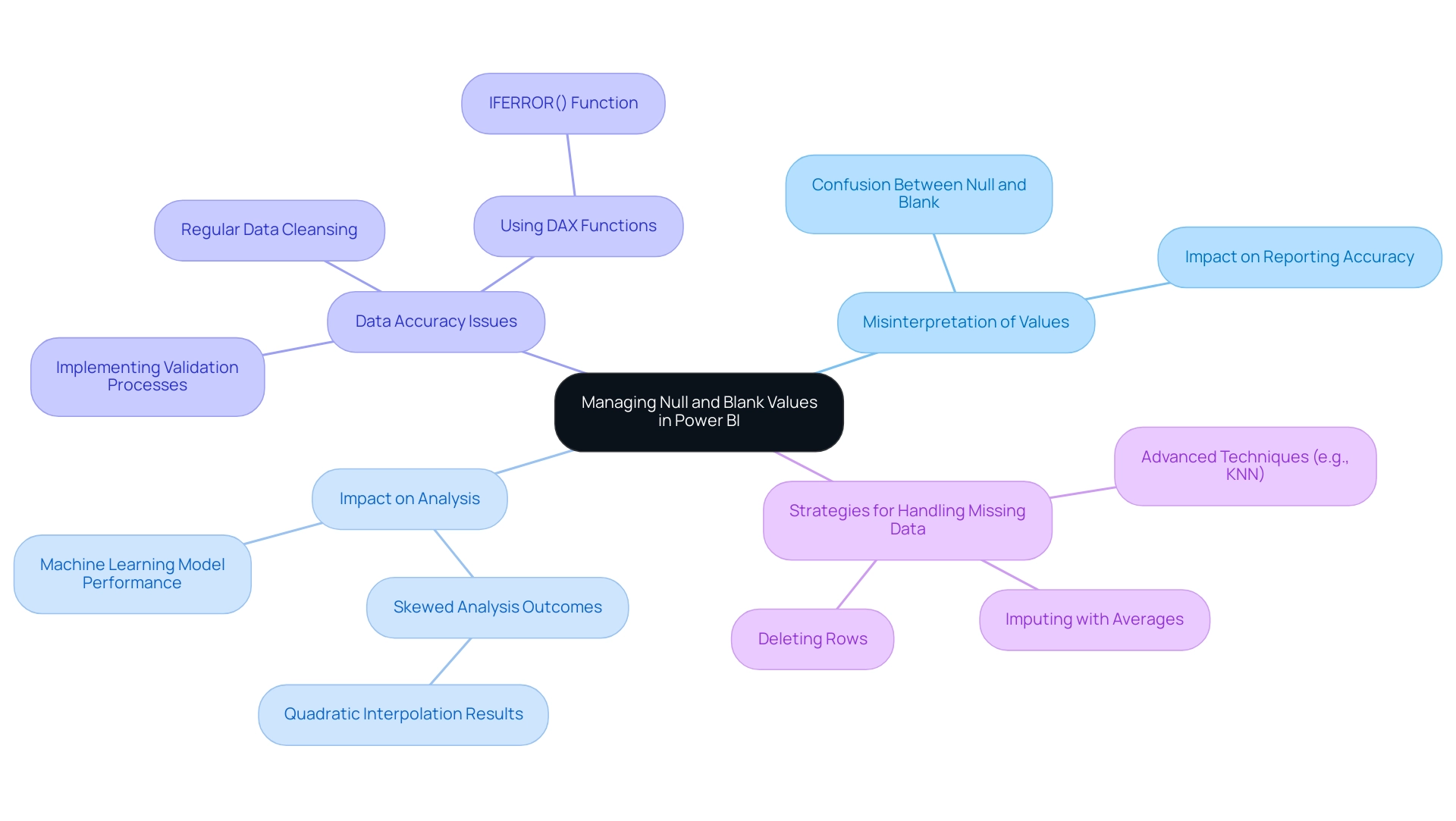
Best Practices for Handling Null and Blank Values in Power BI
Effectively handling empty and missing values, particularly the concepts of power bi null vs blank, is essential for preserving information integrity in Power BI and Power Query, especially considering the difficulties of inadequate master information quality that can hinder AI adoption and overload information systems during a sudden surge of statistical projects. Here are some best practices to consider:
-
Define Information Entry Standards: Establishing and communicating clear information entry standards is essential for ensuring consistency, significantly reducing the occurrence of blanks and empty values.
-
Use Information Validation: Implementing robust validation rules at the source can catch errors early, helping to maintain clean datasets. This step is particularly effective in reducing the occurrence of empty values and ensuring actionable insights from your BI tools.
-
Routine Information Audits: Performing regular assessments of your datasets enables teams to proactively recognize and tackle missing values and empties, thereby ensuring continuous information cleanliness and improving operational efficiency. According to the ‘Ethical Guidelines for Statistical Practice,’ adhering to established information standards is crucial for ethical handling.
-
Employ DAX Functions: Leveraging DAX functions can provide sophisticated solutions for handling power bi null vs blank efficiently within your calculations. Utilizing these functions effectively enhances analytical capabilities and helps mitigate the challenges of time-consuming report creation and inconsistencies.
-
Integrate RPA Solutions: Implementing Robotic Process Automation can significantly streamline quality checks and automate entry processes, reducing the likelihood of errors and enhancing overall integrity.
-
Educate Team Members: Training team members on best practices for information quality is imperative. As noted by quality experts, documentation and communication are important to facilitate the understanding and use of the information by yourself and others. Furthermore, the case study titled ‘Degrees of Freedom in Planning, Running, Analyzing, and Reporting Psychological Studies’ highlights the importance of transparency and adherence to statistical best practices in managing information.
By implementing these practices, organizations can significantly enhance their reliability, leading to more informed decision-making and improved operational efficiency, ultimately positioning them for growth and innovation. This is especially critical in a competitive landscape where poor data quality can hinder AI adoption and limit an organization’s ability to leverage its data assets effectively.
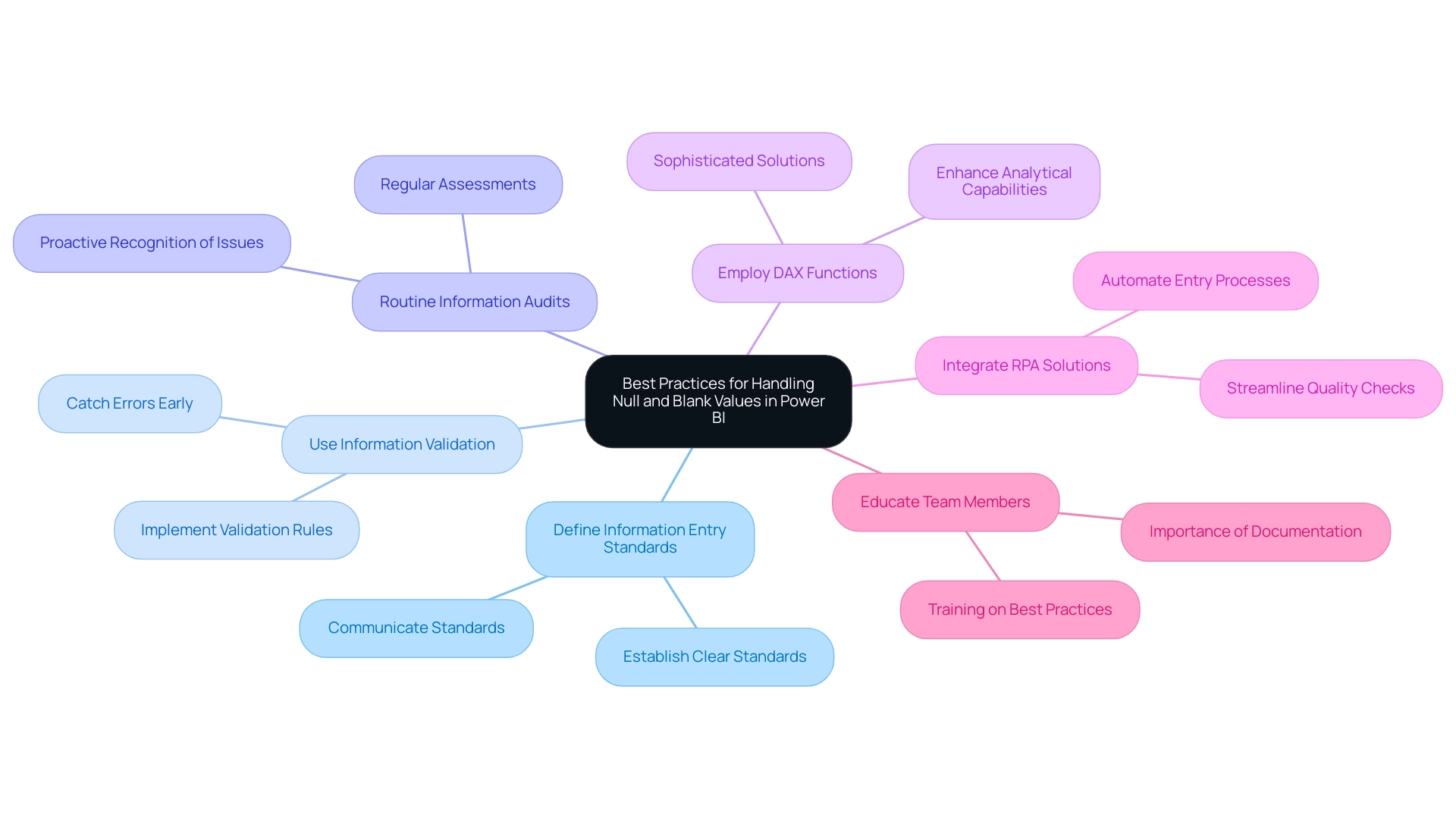
Conclusion
Mastering the management of null and blank values in Power BI is essential for achieving accurate data analysis and reporting. Understanding the distinctions between these values and their implications can significantly enhance the integrity of your data. By employing best practices such as:
- Establishing clear data entry standards
- Utilizing data validation
- Conducting regular audits
organizations can mitigate the risks associated with mismanaged data and unlock the full potential of their Business Intelligence tools.
Moreover, leveraging DAX functions and integrating Robotic Process Automation can streamline processes, reduce errors, and ultimately improve operational efficiency. As organizations embrace these strategies, they are better positioned to make informed decisions that drive growth and innovation. The proactive management of null and blank values not only fosters a culture of data integrity but also empowers teams to derive meaningful insights, ensuring that data becomes a strategic asset rather than a liability.
In a data-driven landscape, the ability to accurately interpret and utilize data is paramount. By prioritizing the effective handling of null and blank values, organizations can enhance their reporting capabilities, streamline operations, and maintain a competitive edge. Now is the time to take actionable steps towards optimizing data management practices to create a more efficient and informed organization.

